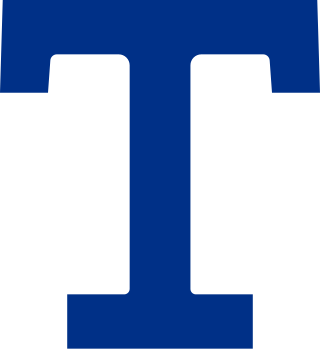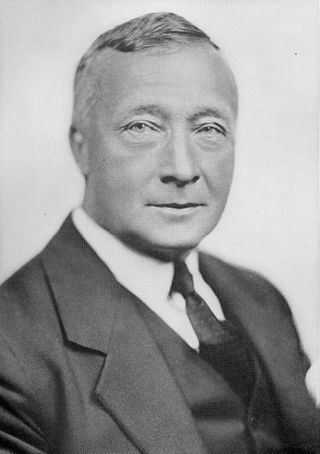
The Toronto Arenas or Torontos were a professional men's ice hockey team that played in the first two seasons of the National Hockey League (NHL). It was operated by the owner of the Arena Gardens, the Toronto Arena Company. As the ownership of the National Hockey Association (NHA) Toronto Blueshirts franchise was in dispute, the new NHL league was started, and a temporary Toronto franchise was operated. The NHL itself was intended to only be a one-year entity until the NHA could be reactivated, although it never was.

The Quebec Bulldogs were a men's senior-level ice hockey team based in Quebec City. The team was officially known as the Quebec Hockey Club, and later as the Quebec Athletic Club. One of the first organized ice hockey clubs, the club debuted in 1878 with the opening of the Quebec Skating Rink. The club continued as an amateur team through various leagues, eventually becoming professional in 1908. The club would play in the National Hockey Association and the National Hockey League. In 1920, the team moved to Hamilton, Ontario and became the Hamilton Tigers.

The Hamilton Tigers were a professional ice hockey team based in Hamilton, Ontario that competed in the National Hockey League (NHL) from 1920 to 1925. The Tigers were formed by the sale of the Quebec Bulldogs NHL franchise to Hamilton interests. After years of struggling, the franchise finished first in the league in the 1924–25 NHL season, but a players' strike before the playoffs resulted in the franchise's dissolution. The players' contracts were sold to New York City interests to stock the expansion New York Americans. A namesake amateur team existed prior to and during the NHL team's existence, and a minor league professional team named the Hamilton Tigers existed from 1926 to 1930.
The National Hockey Association (NHA), initially the National Hockey Association of Canada Limited, was a professional ice hockey organization with teams in Ontario and Quebec, Canada. It is the direct predecessor of today's National Hockey League (NHL), and much of the business processes of the NHL today are based on the NHA. Founded in 1909 by Ambrose O'Brien, the NHA introduced 'six-man hockey' by removing the 'rover' position in 1911. During its lifetime, the league coped with competition for players with the rival Pacific Coast Hockey Association (PCHA), the enlistment of players for World War I and disagreements between owners. The disagreements between owners came to a head in 1917, when the NHA suspended operations in order to get rid of an unwanted owner, Eddie Livingstone.
The 1917–18 NHL season was the first season of the National Hockey League (NHL) professional ice hockey league. The league was formed after the suspension of the National Hockey Association (NHA). Unwilling to continue dealing with Toronto Blueshirts owner Eddie Livingstone, the other NHA team owners formed the NHL, initially as a temporary measure after realizing the NHA constitution did not allow them to force Livingstone out. The Montreal Canadiens, Montreal Wanderers, and Ottawa Senators moved to the NHL. A then-temporary team, the Toronto Hockey Club, was formed to replace Livingstone's team, but the club played without an official nickname for the season. Meanwhile, the Quebec Bulldogs suspended operations prior to the season.
The 1918–19 NHL season was the second season of the National Hockey League (NHL). While at first it was uncertain that the NHL would operate, and the possibility that National Hockey Association (NHA) would be resumed, the unfinished business of Eddie Livingstone's Toronto and Ottawa's NHA franchise, led to the NHL owners suspending the NHA again. Livingstone would attempt to overthrow the NHA management, and failing that, attempt to operate a rival league. The pre-season was filled with legal actions, deceptions and public verbal attacks. Ultimately, the NHL operated with three teams, in Montreal, Ottawa and Toronto. However, the season ended early with Toronto suspending operations, leaving Montreal and Ottawa to play off for the championship. Montreal would win the playoff and travel to Seattle for the Stanley Cup Finals. However, the championship series was not completed due to influenza infecting the whole Montreal team and causing the eventual death of Montreal's Joe Hall.

Frank Sellick Calder was a British-born Canadian ice hockey executive, journalist, and athlete.

The Toronto Hockey Club, known as the Torontos and the Toronto Blueshirts, were a professional ice hockey team based in Toronto. They were a member of the National Hockey Association (NHA). The club was founded in 1911 and began operations in 1912. The club won its sole Stanley Cup championship in 1914.

Edward James Livingstone was a Canadian sports team owner and manager. He was the principal owner of the Toronto Shamrocks and the Toronto Blueshirts professional ice hockey clubs of the National Hockey Association (NHA), where his battles with his fellow owners led them to create the National Hockey League.
The 1910–11 NHA season was the second season of the now defunct National Hockey Association. The Ottawa Hockey Club won the league championship. Ottawa took over the Stanley Cup from the Montreal Wanderers and defended it against teams from Galt, Ontario, and Port Arthur, Ontario.
Les Canadiens was the original name of the Montreal Canadiens professional ice hockey team in the National Hockey Association (NHA), as used in the 1910 season. This was the founding season of the Canadiens hockey club, which now is a franchise member of the National Hockey League (NHL).
The 1915–16 NHA season was the seventh season of the National Hockey Association. Five teams played a 24 game schedule. Montreal Canadiens won the league championship and defeated the Portland Rosebuds to win their first ever Stanley Cup.
The 1918 Stanley Cup Finals was contested by the National Hockey League (NHL) champion Toronto and the Pacific Coast Hockey Association (PCHA) champion Vancouver Millionaires. In a series held entirely in Toronto, the Toronto team won the series by three games to two in the best-of-five game series to win the Stanley Cup. It was the first series contested by the new NHL and subsequently the first Stanley Cup win by the Toronto NHL franchise team.
The 1916–17 NHA season was the eighth and final season of the National Hockey Association. Six teams were to play two half-seasons of ten games each, but this was disrupted and only four teams finished the season. The Montreal Canadiens defeated the Ottawa Senators in a playoff to win the NHA championship.

The 1917–18 Toronto Hockey Club season was the first season of the new Toronto franchise in the newly-organized National Hockey League (NHL). The team was intended as a 'temporary' franchise, operating without an official club nickname and without a formal organization separate from the Toronto Arena Company that managed the Arena Gardens. Despite this, the team came together to win the first NHL Championship, competing against existing teams that had transferred directly from the National Hockey Association (NHA). Toronto would go on to win the Stanley Cup by defeating the Pacific Coast Hockey Association champion Vancouver Millionaires – the first Stanley Cup for an NHL team and the second Cup for a Toronto team after the Toronto Blueshirts' victory in the 1913–14 season of the NHA. To this day, the Toronto Arenas are the only team in the four major North American sports to win the title in their first season as a franchise.

The National Hockey League (NHL) was founded in 1917 following the demise of its predecessor league, the National Hockey Association (NHA). In an effort to remove Eddie Livingstone as owner of the Toronto Blueshirts, a majority of the NHA franchises suspended the NHA and formed the new NHL. The Quebec Bulldogs, while a member, did not operate in the NHL for the first two years. Instead the owners of the Toronto Arena Gardens operated a new Toronto franchise. While the NHL was intended as a temporary measure, the continuing dispute with Livingstone led to the four NHA owners meeting and making the suspension of the NHA permanent one year later.
The 1917–18 Montreal Canadiens season was the team's ninth season and first as a member of the new National Hockey League (NHL). The Canadiens sided with other members of the National Hockey Association (NHA) and voted to suspend the NHA and start the NHL to expel the Toronto Blueshirts ownership. The Canadiens qualified for the playoffs by winning the first half of the season, but lost the playoff to the temporary Toronto franchise, made up of Blueshirts players.
The 1918–19 Toronto Arenas season was the second season of the Toronto franchise of the National Hockey League. After being operated on a temporary basis in the previous year, the team became a formal entity, known as the 'Toronto Arena Hockey Club.' The club played 18 games and suspended operations.

Major Frank G. Robinson was a Canadian ice hockey executive and soldier from Montreal. He was an owner of the Toronto Blueshirts ice hockey team and later, president of the National Hockey Association (NHA), a predecessor organization of the National Hockey League (NHL).

Thomas Emmett Quinn was a Canadian ice hockey executive, coach and referee. Quinn served as president of the National Hockey Association (NHA), the predecessor of today's National Hockey League (NHL). His brother Percy Quinn was also an ice hockey executive. At the time of his death, Quinn was a Fire Commissioner in Montreal.









